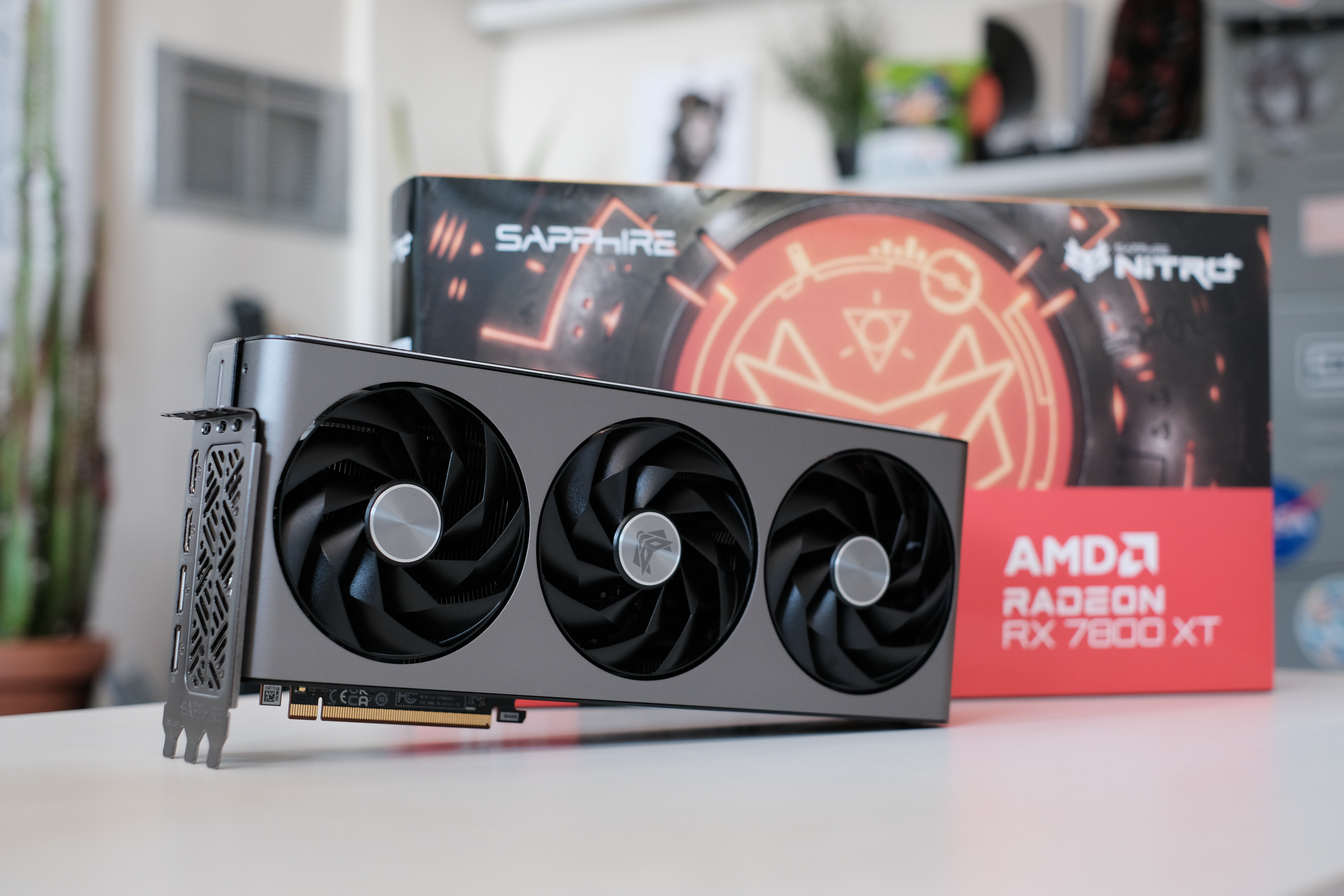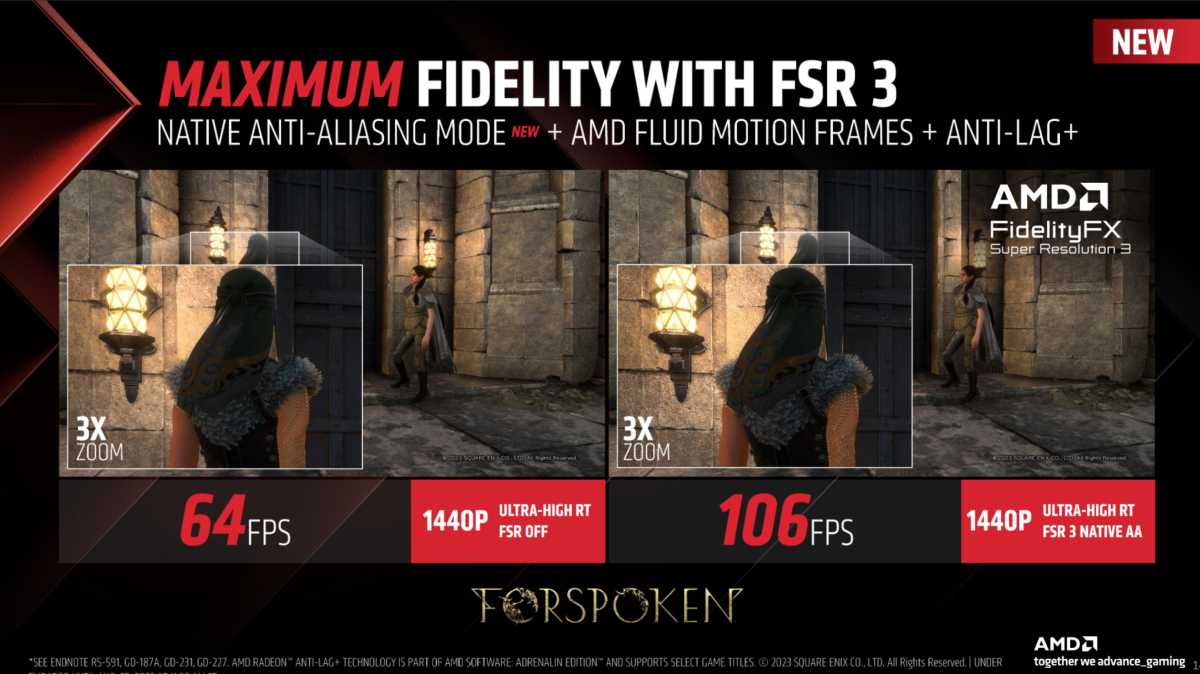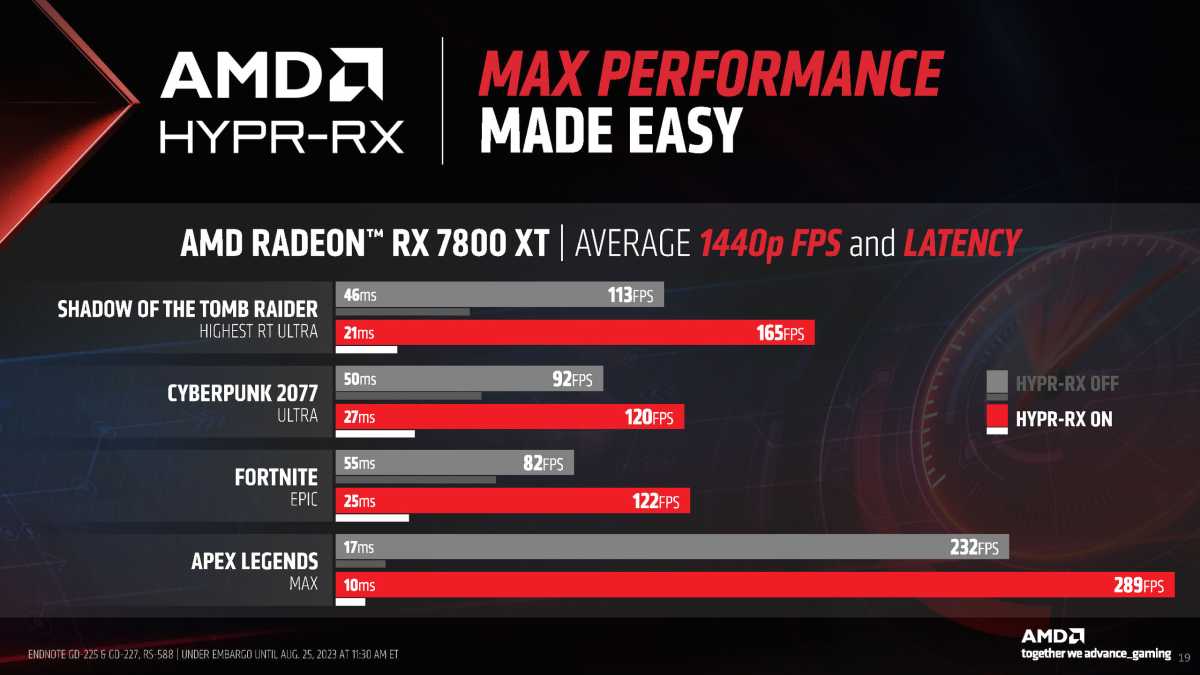- Регистрация
- 17 Февраль 2018
- Сообщения
- 22 703
- Лучшие ответы
- 0
- Баллы
- 2 093
Offline
AMD presented its latest performance-boosting technology FidelityFX Super Sampling 3 (FSR 3) at Gamescom 2023 in Cologne, Germany, but what is behind the numerous new features, such as Fluid Motion Frames or the new Native Mode, and what are HYPR-RX and the extended latency enhancer Radeon Anti-Lag+ actually good for?
We present AMD’s latest temporal upscaler with intermediate frame calculation and its entire feature set in detail and explain what advantages gamers have from the technology.
AMD FSR 3 with Fluid Motion Frames
During the keynote of its in-house AMD Gaming Festival 2023 at Gamescom 2023, the chip manufacturer also released all the technical information on its long-awaited latest upscaling technology, FSR 3, in addition to its two new midrange graphics cards, the AMD Radeon RX 7800 XT and the AMD Radeon RX 7700 XT, based on the current RDNA-3 architecture.
Also demonstrated were Fluid Motion Frames technology, an interframe calculation for significantly higher frame rates and more frames per second (fps), as well as HYPR-RX with Radeon Anti-Lag+.
AMD Radeon RX 7800 XT

Best Prices Today: $519.99 at Best Buy
AMD FSR 3 for all graphics cards
AMD’s third-generation FidelityFX Super Resolution — FSR 3 for short — will run on all graphics cards, which officially includes the following series and generations:
Basically, FSR 3, which has to be supported by game developers and integrated into their games accordingly, including the new interframe calculation via fluid motion frames, also runs on all other graphics cards from older generations.
AMD’s gaming boss, who is also responsible for the Radeon graphics cards, commented on this at Gamescom 2023 as follows:
AMD FSR 3 is an open technology that does not require machine learning hardware and therefore can be supported on a wide range of products and platforms, including gaming consoles.
FSR 3 is supported by graphics cards based on the RDNA 1 architecture and newer, but we recommend using it with graphics cards based on the RDNA 2 architecture and RDNA 3 architecture.
FSR 3 is also supported by a wide range of third-party solutions, including Nvidia Geforce RTX 2000, 3000, and 4000.
Frank Azor, AMD
AMD stressed that proper operation can only be guaranteed on officially supported graphics cards from the first generation of RDNA and the highest possible quality only on graphics cards from the second generation RDNA. In general, however, FSR 3 runs on all graphics cards from AMD, Nvidia, and Intel, according to the manufacturer.
Fluid Motion Frames in detail
AMD promises gamers an extremely significant increase in performance with Fluid Motion Frames Technology and promises a doubling of performance in direct comparison to the in-house predecessor FSR 2.x without intermediate frame calculation.
With FSR 2, we already calculate more pixels than we have samples in the current frame, and we realized that we could generate even more by introducing interpolated frames. This allowed us to increase the frame rate with FSR 3 by another factor of 2 compared to FSR 2.
AMD
During the presentation, the manufacturer went into further detail and showed a “Deep Dive” on the “Fluid Motion Frames Technology,” which, as a kind of interpolation process between every two rendered frames, can insert an additional frame “in between.”
Compared to rendering without upscaling technology, the frame rate should even be quadrupled in some cases, as AMD demonstrates.

AMD
In FSR 3 with fluid motion frames, there is a high probability that there is at least one sample for each interpolated pixel and no feedback loop, as the interpolated frame is only displayed once.
Possible artefacts as a result of the interpolation process would thus only remain for a single frame. AMD has provided a rendering pipeline with a native, an FSR 2, and an FSR 3 model and compares them with each other.

AMD
By using fluid motion frames for intermediate frame calculation, AMD promises an average doubling of frames per second (fps) compared to FSR 2, competing directly with Nvidia’s DLSS 3 with Frame Generation.
AMD has documented the expected performance gain in a first video and provides corresponding impressions.
Fluid Motion Frames also in the driver
In addition to FSR 3 with Fluid Motion Frames, which will celebrate its premiere in the action role-playing game Forspoken and in the fantasy shooter Immortals of Aveum, AMD also wants to offer the intermediate image calculation directly in the graphics driver from the first quarter of 2024.
Fluid Motion Frames in the driver should be applicable to all games that use Microsoft’s DirectX 11 and DirectX 12 graphics interfaces. However, this feature will be reserved exclusively for the current graphics cards of the RDNA-3 generation.
The driver mode will also not be able to keep up with the FMF integration in games in terms of quality, as AMD has emphasized several times. It is more a kind of “emergency mode” to quickly generate more frames.
Native Mode for highest image quality
the best 1080p graphics card supports fsr 3
AMD Radeon RX 7600

Price When Reviewed: 299 Euro
The new Native Mode, also presented at Gamescom 2023, is the second major innovation of FidelityFX Super Resolution 3 alongside Fluid Motion Frames technology (“FMF”) and is supposed to deliver nothing less than “the best graphics quality” along the lines of Nvidia’s Deep Learning Anti Aliasing (“DLAA”).
While FSR 3 and its presets are only supposed to offer slightly better picture quality compared to FSR 2, AMD wants to score points here with the so-called Native Mode.
This mode applies the algorithm on which FSR 3 is based to the image, but uses the native resolution instead of upscaling. The minimum requirement for this should be a Radeon RX 5000 (“RDNA”) or GeForce RTX 2000 (“Turing”) graphics card.
Note: The output resolution of the image corresponds 1:1 to the internally rendered resolution. An intermediate image calculation via FMF can be optionally added if desired.

AMD
The Native Mode allows gamers to play in native resolution and to have the picture quality upgraded by the FidelityFX super resolution algorithm.
AMD recommends counteracting the possible performance losses accordingly with the Fluid Motion Frames already described.
HYPR-RX and Radeon Anti-Lag+
The universal tool “HYPR-RX,” which has also been announced for months and which is combined with the latency enhancer “Radeon Anti-Lag+” serves as a supplement to FSR 3 and bundles all features in one mode.
HYPR-RX and its presets can be easily accessed and activated via AMD’s graphics driver, the AMD Radeon Software Adrenalin Edition.
HYPR-RX can combine the following technologies:
*) from Q1/2024
At the push of a button, this should not only increase frame rates but also significantly reduce latencies, as AMD has demonstrated on a Radeon RX 7800 XT.

AMD
The integration of Radeon Boost and Radeon Chill should also limit power consumption and save energy.
Like the FMF driver mode, HYPR-RX and Radeon Anti-Lag+ will remain exclusive to RDNA-3 graphics cards. The features are to be included in the graphics driver in September.
FSR 3 and all new features in a deep dive
For gamers who want to find out more about FSR 3, Fluid Motion Frames, and all the new features, the manufacturer has made the entire AMD Gaming Festival 2023 available in a video that is around three hours long.
If you are still looking for a suitable Radeon graphics card, PCWorld’s big graphics card comparison 2023 is the right place to go.
This article was translated from German to English and originally appeared on pcwelt.de.
Graphics Cards, Science & Technology
We present AMD’s latest temporal upscaler with intermediate frame calculation and its entire feature set in detail and explain what advantages gamers have from the technology.
AMD FSR 3 with Fluid Motion Frames
During the keynote of its in-house AMD Gaming Festival 2023 at Gamescom 2023, the chip manufacturer also released all the technical information on its long-awaited latest upscaling technology, FSR 3, in addition to its two new midrange graphics cards, the AMD Radeon RX 7800 XT and the AMD Radeon RX 7700 XT, based on the current RDNA-3 architecture.
Also demonstrated were Fluid Motion Frames technology, an interframe calculation for significantly higher frame rates and more frames per second (fps), as well as HYPR-RX with Radeon Anti-Lag+.
AMD Radeon RX 7800 XT

Best Prices Today: $519.99 at Best Buy
AMD FSR 3 for all graphics cards
AMD’s third-generation FidelityFX Super Resolution — FSR 3 for short — will run on all graphics cards, which officially includes the following series and generations:
- AMD Radeon RX 7000 (“RDNA 3”)
- AMD Radeon RX 6000 (“RDNA 2”)
- AMD Radeon RX 5000 (“RDNA 1”)
- Nvidia GeForce RTX 4000 (“Ada Lovelace”)
- Nvidia GeForce RTX 3000 (“Ampere”)
- Nvidia GeForce RTX 2000 (“Turing”)
- Intel Arc (“Alchemist”)
Basically, FSR 3, which has to be supported by game developers and integrated into their games accordingly, including the new interframe calculation via fluid motion frames, also runs on all other graphics cards from older generations.
AMD’s gaming boss, who is also responsible for the Radeon graphics cards, commented on this at Gamescom 2023 as follows:
AMD FSR 3 is an open technology that does not require machine learning hardware and therefore can be supported on a wide range of products and platforms, including gaming consoles.
FSR 3 is supported by graphics cards based on the RDNA 1 architecture and newer, but we recommend using it with graphics cards based on the RDNA 2 architecture and RDNA 3 architecture.
FSR 3 is also supported by a wide range of third-party solutions, including Nvidia Geforce RTX 2000, 3000, and 4000.
Frank Azor, AMD
AMD stressed that proper operation can only be guaranteed on officially supported graphics cards from the first generation of RDNA and the highest possible quality only on graphics cards from the second generation RDNA. In general, however, FSR 3 runs on all graphics cards from AMD, Nvidia, and Intel, according to the manufacturer.
Fluid Motion Frames in detail
AMD promises gamers an extremely significant increase in performance with Fluid Motion Frames Technology and promises a doubling of performance in direct comparison to the in-house predecessor FSR 2.x without intermediate frame calculation.
With FSR 2, we already calculate more pixels than we have samples in the current frame, and we realized that we could generate even more by introducing interpolated frames. This allowed us to increase the frame rate with FSR 3 by another factor of 2 compared to FSR 2.
AMD
During the presentation, the manufacturer went into further detail and showed a “Deep Dive” on the “Fluid Motion Frames Technology,” which, as a kind of interpolation process between every two rendered frames, can insert an additional frame “in between.”
Compared to rendering without upscaling technology, the frame rate should even be quadrupled in some cases, as AMD demonstrates.

AMD
In FSR 3 with fluid motion frames, there is a high probability that there is at least one sample for each interpolated pixel and no feedback loop, as the interpolated frame is only displayed once.
Possible artefacts as a result of the interpolation process would thus only remain for a single frame. AMD has provided a rendering pipeline with a native, an FSR 2, and an FSR 3 model and compares them with each other.

AMD
By using fluid motion frames for intermediate frame calculation, AMD promises an average doubling of frames per second (fps) compared to FSR 2, competing directly with Nvidia’s DLSS 3 with Frame Generation.
AMD has documented the expected performance gain in a first video and provides corresponding impressions.
Fluid Motion Frames also in the driver
In addition to FSR 3 with Fluid Motion Frames, which will celebrate its premiere in the action role-playing game Forspoken and in the fantasy shooter Immortals of Aveum, AMD also wants to offer the intermediate image calculation directly in the graphics driver from the first quarter of 2024.
Fluid Motion Frames in the driver should be applicable to all games that use Microsoft’s DirectX 11 and DirectX 12 graphics interfaces. However, this feature will be reserved exclusively for the current graphics cards of the RDNA-3 generation.
The driver mode will also not be able to keep up with the FMF integration in games in terms of quality, as AMD has emphasized several times. It is more a kind of “emergency mode” to quickly generate more frames.
Native Mode for highest image quality
the best 1080p graphics card supports fsr 3
AMD Radeon RX 7600

Price When Reviewed: 299 Euro
The new Native Mode, also presented at Gamescom 2023, is the second major innovation of FidelityFX Super Resolution 3 alongside Fluid Motion Frames technology (“FMF”) and is supposed to deliver nothing less than “the best graphics quality” along the lines of Nvidia’s Deep Learning Anti Aliasing (“DLAA”).
While FSR 3 and its presets are only supposed to offer slightly better picture quality compared to FSR 2, AMD wants to score points here with the so-called Native Mode.
This mode applies the algorithm on which FSR 3 is based to the image, but uses the native resolution instead of upscaling. The minimum requirement for this should be a Radeon RX 5000 (“RDNA”) or GeForce RTX 2000 (“Turing”) graphics card.
Note: The output resolution of the image corresponds 1:1 to the internally rendered resolution. An intermediate image calculation via FMF can be optionally added if desired.

AMD
The Native Mode allows gamers to play in native resolution and to have the picture quality upgraded by the FidelityFX super resolution algorithm.
AMD recommends counteracting the possible performance losses accordingly with the Fluid Motion Frames already described.
HYPR-RX and Radeon Anti-Lag+
The universal tool “HYPR-RX,” which has also been announced for months and which is combined with the latency enhancer “Radeon Anti-Lag+” serves as a supplement to FSR 3 and bundles all features in one mode.
HYPR-RX and its presets can be easily accessed and activated via AMD’s graphics driver, the AMD Radeon Software Adrenalin Edition.
HYPR-RX can combine the following technologies:
- FidelityFX Super Resolution (“FSR”) 2
- FidelityFX Super Resolution (“FSR”) 3 + Fluid Motion Frames (“FMF”)
- Fluid Motion Frames technology per driver mode*
- Radeon Super Resolution (“RSR”)
- Radeon Anti-Lag+
- Radeon Boost
- Radeon Chill
*) from Q1/2024
At the push of a button, this should not only increase frame rates but also significantly reduce latencies, as AMD has demonstrated on a Radeon RX 7800 XT.

AMD
The integration of Radeon Boost and Radeon Chill should also limit power consumption and save energy.
Like the FMF driver mode, HYPR-RX and Radeon Anti-Lag+ will remain exclusive to RDNA-3 graphics cards. The features are to be included in the graphics driver in September.
FSR 3 and all new features in a deep dive
For gamers who want to find out more about FSR 3, Fluid Motion Frames, and all the new features, the manufacturer has made the entire AMD Gaming Festival 2023 available in a video that is around three hours long.
If you are still looking for a suitable Radeon graphics card, PCWorld’s big graphics card comparison 2023 is the right place to go.
This article was translated from German to English and originally appeared on pcwelt.de.
Graphics Cards, Science & Technology
